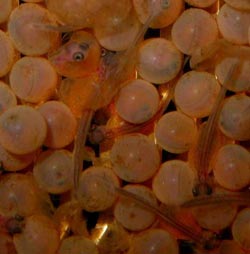Staff at the Environment Agency in the North East have successfully reared 15,000 rare fish at their hatchery in Kielder. The fish are Ennerdale Arctic Charr which are unique to Ennerdale Water in the Lake District and have existed since the Ice Age. However, over recent years the numbers of Ennerdale charr have declined dramatically and now there are only believed to be a few hundred left, so staff at Kielder Hatchery worked with their Environment Agency colleagues in the North West to help save the lake’s species. Hatchery officer Richard Bond said: “Ennerdale charr have developed different characteristics to other charr which is why it is so important that they survive. Eggs were taken from adult charr in the lake and brought to the hatchery where they were fertilised and incubated. “We have now got around 15,000 fish which are ready to go back to Ennerdale and these will hopefully breed and boost the population.” Kielder staff had to keep the water in the breeding tanks below 6C to help the eggs to hatch, which took more than two months. North West fisheries officer Suzi Hawkins said: “It is likely that Ennerdale’s charr are genetically different because they have long been an isolated population with no other charr able to reach the lakes from cold northern seas to breed. They are also the only charr population in England which spawn exclusively in the burns that feed the lake. “Thanks to the dedication of the staff at the Kielder hatchery, the charr have been given the best possible chance of survival when they are returned to the lake in June.” The Kielder hatchery was built 28 years ago to breed salmon for the River Tyne. They now breed around 700,000 salmon a year and 160,000 of these are released into the River Trent in the Midlands every autumn as part of a salmon restoration programme. The Kielder team has also been trying to breed freshwater pearl mussels, which have difficulty breeding in the wild due to pollution and loss of habitat. One of the species’ last remaining strongholds is in the north of England, and staff have been trying different techniques to encourage them to reproduce at the hatchery. Visitors to Kielder will soon be able to discover more about work at the hatchery thanks to a refurbishment of its visitor centre which is due to be opened next year. |
Welcome!Log into your account











